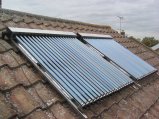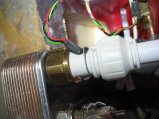Solar Thermal installation
The original dip in the solar loop before the PHE didn't allow for bleeding at this local high point, and I made it sping a slow leak as I tried to stuff insulation in so decided to improve this bit by adding a bleed point as well as soldering the 10mm pipe rather than using a compression fitting. Definately better.
















